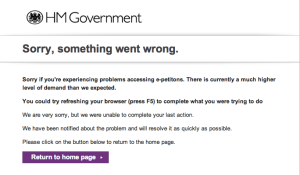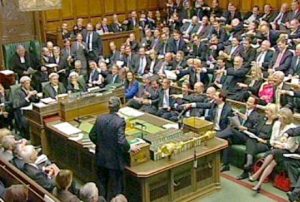Most campaigns are looking to get government policies changed, but what can we learn from those working in government about what makes a policy success?
The Institute for Government has recently published a fantastic paper, which looks at what makes a ‘policy success’, drawing on insights from number of ‘policy reunions’ that were held with senior civil servants and government ministers involved in a range of ‘policy successes’ over the last 30 years.
These success including the introduction of the National Minimum Wage, to the Climate Change Act, and Privatisation in the 80s (I appreciate some readers wouldn’t see this as policy success!’).
The report defines a ‘policy success’ as “the most successful policies are ones which achieve or exceed their initial goals in such a way that they become embedded; able to survive a change of government; represent a starting point for subsequent policy development or remove the issue from the immediate policy agenda”.
Then sets out to identify some common factors which lie behind these successes, before providing detailed case studies for each of the issues. I’d recommend reading the paper for anyone who is interested in getting the perspective from the ‘other side of the fence’ about how ministers and civil servants perceive who successful policies come about.
For campaigners, I’ll concentrate on three of the factors that I think our noteworthy for our planning;
1 – Need for strong leadership. The paper suggests that in all of the cases they have benefited from a senior minister who has taken a personal interest in passing the legislation, in some cases staking their personal reputation on it coming about, but also having officials with credibility working on the issue.
In the case of climate change the paper cites the role that David Miliband played when he joined DEFRA and also the role of Sir David King, the Chief Scientist in highlighting that the issue was a bigger threat than terrorism.
For me this is a validation of the strategy that some campaigns use to make a particular minister a ‘champion’ for the topic, but also raise a note of caution of the difficultly of getting an issue on a ministers agenda if they’ve already decided what their priorities are going to be.
It also suggests that campaign can do more to make use of those posts within Whitehall, like the Chief Scientist, Chief Medical Officer, etc who are able to give independent advice from a position of authority within Whitehall.
2 – It takes time. Those involved in the discussions that helped to inform the paper are all quick to suggest that for most of the policy success the groundwork and ideas had taken significant amount of time to develop.
For example, the paper argues that much of the work that lead to the creation of the Low Pay Commission that brought in the minimum wage was done while the Labour Party was in opposition in the mid-90s, where some of the most contentious issues were raised and began to be addressed. This meant that when they won the 1997 election they were able to give extensive proposals to officials.
This lesson, coupled with the suggestion from some in the paper that the first year or so after an election are the critical window of opportunity, suggest that organisations that are looking to achieve policy change in the medium to long-term, perhaps because a proposal isn’t getting traction with the current government, would do well to engage in the ‘long game’ of opposition policy making.
3 – A robust evidence base – This factor is unlikely to come as a surprise to most campaigning organisations, whose campaigning is grounded in policy work, but the paper affirms the need for good evidence and analysis, but it also goes further by highlighting that the creation of an independent group/individual to look at the issue, like the Pension Commission or the Stern Report on Climate Change, were critical in providing the evidence that allowed governments to act on the issues, and providing a basis for the consensus necessary from all involved.
In the case of the Climate Change Act and the Ban on Smoking in Public Places, the paper has much to say about the important role that organisation like Friends of the Earth and Action on Smoking and Health (ASH) played in influencing the final outcome and providing ideas from outside government.
For learning from the ‘other side’ I’d strongly recommend a read of this report, as it provides some excellent challenges for the way in which we go about trying to get policies changed. If you read it, I’d welcome your comments and reflections.
Be first to know about new posts by subscribing to the site using the box on the right, adding http://thoughtfulcampaigner.org/ to your RSS feed or following me on twitter (@mrtombaker)
Category: government
The National Trust – the UKs most influential campaigning charity?
The Guardian had an interview with Dame Fiona Reynolds, the Director General of the National Trust on Saturday, where it asks if she is the most powerful woman in Britain at the moment based on the way that the organisation is currently campaigning against reforms to planning laws that threaten the countryside.

While, we don’t have a way of systematically ranking organisations based on influence, I think that the National Trust could make a genuine claim to be one of the most influential campaigning organisations in the country at the moment. Here’s why.
1. Membership – The National Trust announced earlier in the month that their paid membership is now over 4 million, that’s around 1 in every 10 voters. I’d suggest that many of these members are based in marginal constituencies around the country, as well as in safe Conservative areas, for example Surrey is the county with the most members. That means its members views are likely to be heard by lots of Tory MPs. Moreover, I’m sure that many MPs, Lords and other key influencers are also members, and share a natural affinity with the organisations aims.
Their reach is simply put enormous, with a membership far bigger than any single political party or trade union in the UK. Moreover, I suspect many members of the National Trust wouldn’t see themselves as the ‘campaigning types’ so the organisation has an opportunity to introduce campaigning to a whole new audience.
2. Influence – As Dame Reynolds says in her interview, the National Trust doesn’t want to be ‘became rentaquote, that wouldn’t be right. We reserve our voice for something that is really important, absolutely at the heart of our core purpose and touches what we stand for and where we make a difference’.
As such I’m sure when the National Trust chooses to campaign on an issue I’m sure it send panic through the heart of the government. They’ve proven they can mobilise hundreds of thousands of people to take action, most recently collecting 200,000 actions on a petition around the changes to planning legislation, and a look at the Guardian data on ministerial meetings suggest that the National Trust has met with ministers from across Whitehall.
But equally they’re smart about selecting issues that they campaign on, with Dame Reynolds saying they’d only work on issues that are ‘central to what we do and I suspect it would be rare, but when we make a contribution it matters’. Their influence meant that when they speak up those at the top of Government need to act, for example the Prime Minister recently writing to say ‘we should cherish and protect it [the countryside] for everyone’s benefit‘ in response to the Trusts most recent campaign.
3. Communications Reach – The organisations magazine has the 6th biggest magazine circulation in the UK, and is estimated to reach over 3.75 million people, which provides a great platform to inform and mobilise individuals to take action, imagine inserting a campaign postcard into every one that gets mailed. While their social media penetration is also impressive, the recent Charity Social 100 Index put them at number 7 and they have over 40,000 followers on twitter. All add up to a significant base from which they can mobilise.
Do you agree? What criteria would you use to identify the most ‘influential’ charity?
Thoughts on the first week of epetitions.direct.gov.uk
It’s a week since the Government launched its e-petition website, so what have we learnt from the first 7 days?
Update 12/8 – 1,806 petitions have been added in the sites first week, of those 152 have gained only 1 signature and only 28 have gained more the 1,000.
1 – The site can’t cope with surges in traffic.
It was perhaps to be expected that the site would go down on the first day, indeed it’s almost a tradition for new government sites which have all failed to anticipate the number of people visiting. But it’s also been down for much of today (Wednesday) as people have surged to sign a petition to remove benefits from those convicted of rioting in London which has gained over 79,000 signatures very quickly. I’d be concerned that the site wouldn’t be able to cope if an organisation with big mailing list asked its supporters to take action by signing a petition.

2 – The social media integration isn’t that bad…
Each petition page has buttons that allow you to broadcast the petition via twitter, Facebook and Linkedin which is good to see, but as Pete Taylor points out that site could have gone much further suggesting designed should ‘build out the e-petition system as an API – an ‘API’ allows other pieces of software to access a system….organisations could feature the petitions on their websites and recruit activists to their own email and supporter databases at the same time’
3 – But finding a petition could be much easier
One of the most disappointing aspect of the site is the homepage, which list the petitions by most recent one put up as a default option and provides two other options which allow you to sort by title and number of signatures. The search function is satisfactory, and they’re also listed by department but it would have been nice to see other ways of finding petitions, and perhaps details of the latest, most signed and most signed in the last 24 hours detailed on the home page.
4 – It’s social media that’s driving traffic to the site.
Last Thursday was a great case study for this. The petition to bring back capital punishment, which had been championed by blogger Guido Fawkes was heavily trailed in the newspaper and TV but by the end of the day it’d only got 3,000 signatures.
Contrast that to a counter petition to retain the ban on capital punishment which was promoted almost exclusively on twitter until Newsnight covered it which got 6,000 in the first day. A week later it’s still well ahead of the supposedly ‘higher profile’ petition. Similarly, it looks like much of the traffic to the London rioting petition has come from Facebook/Twitter as the media hasn’t been interested in covering it, bit.ly suggests that its been shared over 65,000 times on Facebook.
5 – Those behind it are more agile than expected.
I wrote last week that one of my concerns was that it’d take 7 days for petitions to be approved, which would make it hard for petitions to capitalise on what’s happening in the media. Given that the first report of recent events in London came through on Saturday night, the London rioting petition shows that it’s possible for those working on it to turn around petitions quicker than that.
6 – I’m already a little bored of it.
As I write the top petitions are on very similar subjects to those that were around on the No10 petition site, it’s almost predictable and as yet it doesn’t seem to have generated any interesting new ideas for Parliament to debate.
This is perhaps in part down to the format that requires any petition to get over the 100,000 signature threshold, which means many campaigns will feel that they can’t make target but also the lack of flexibility in the system. I’m expecting some media coverage of the first petition that makes it over the 100,000 line and the first to be debated, but after that I’m not sure how much interest its going to generate.
What are your thoughts or reflections from the first week of the e-petition site?
Should we get excited about the e-petition site?
Thursday will see the first petitions go live on the Governments new e-petition website (http://epetitions.direct.gov.uk/index.html) which is designed to replace the No10 Petition site that was closed after the last election. On the new site any petition that gets over 100,000 names on it ‘could’ be debated in Parliament. I’ve written a separate post here about how to set up a petition.
Undoubtedly it’ll get some coverage in the coming days as the first few petitions go live and reach the target, blogger Guido Fawkes has already launched a campaign for a vote on reintroducing capital punishment and I’m sure he’ll be the first to get over 100,000 names.
Overall the 100,000 target seems appropriate, although only 8 petition on the old No10 site achieved this. My work on campaign totals suggest that no campaigns in the last 12 months managed to achieve that target, but the numbers that campaign groups like 38 Degrees have been mobilising recently shows that its possible for any organisation that put effort into achieving it.
After over a year of waiting for the new e-petition it appears that we’ve lost a certain amount of transparency.
The old system allowed you to view a list of those who’d signed up and also saw that most petitions that generated a significant number of actions got a response from the relevant department, something that at present it doesn’t look like this will happen with the new site.
The main gain is the opportunity to have the issue debated in Parliament if you reach the 100,000 target, but for me that seems to be about it.
Time will tell how it’ll work out. I’ve written before about why I was pleased to see the closure of the old site, but here are a few early thoughts on the approach that’s being taken;
1. Too Long – Campaigning is increasingly about agility so indicating that petitions will take 7 days to be approved by government departments is going to slow things down and make it hard for organisations to capitalise on public concern about an issue that is in the media.
2. Engaging citizens – It’s a shame that the overhaul of the system hasn’t allowed for more thought to be put in about different ways that individuals could sign the petition. The European Union announced a similar (albeit more bureaucratic) process earlier this year, which allowed citizens to submit their names in a number of different formats rather than requiring everyone to get to a computer (and have an email address).
3. Preventing abuse – The eDemocracy blog suggests that it’s not been possible to provide a system to verify that those signing are from the UK or avoid people add multiple signatures. I accept that this would add another layer of complexity (and cost) but if this is a serious attempt to open up the political debate should more thought been put into this?
4. Control – I’m concerned about the fact that you can opt-in to get a response to the government, but not provision is being made to those who set up the petition to contact those who have signed. I’m not clear what most campaigning organisations have to gain from using a system like this.
5. Scale – While 100,000 is probably the right number for a nationwide petition, it seems a shame an option hasn’t been made for petitions on local issues or concern where getting the current target might be impossible. For example, it’d be nice to have seen the option for 25,000 signatures from a county/constituency on a local issue to lead to debate.
6. Outcome – Say you’ve done all the hard work and got 100,000 people to sign the petition, what do you get from it? A debate in Parliament, it’s not clear if the debate will lead to a vote, or simply a debate similar to the format of a Westminster Hall debate, where a minister is required to respond.
If it’s the latter then is a strategy of engaging interested MPs more effective, while those organisations looking to introduce new legislation would do as well to engage MPs who do well in the Private Members Bill ballot.
As one backbench Conservative MP noted; “This scheme is a gimmick. It is vacuous and meaningless. The Government already ignores debates and motions in Parliament that are inspired by backbench MPs. So what notice are they going to take of debates forced by petitions? “
Will you be making use of the e-petition site? Is it a helpful contribution to campaigning?
How the e-petition site works
The process for setting up an e-petition on the new website is simple. Here is a step by step guide adapted from the Governments website.

1. Submit – The title can be up to 150 characters (although if you want to tweet it you’ll want it be shorter) with the petition itself up to 1000 characters. When you write it consider the criteria that it’ll be judged against, including the need for a request for action.
You also need to specify the department responsible for the issue your petition is on and the length of time you’d like the petition to run for (3, 6, 9 or 12 months).
On the next page you’ll need to submit your details (name, address, email) which appear to require an individual rather than an organisation to create it.
2. Petition Checked – It’ll then take up to 7 days for your petition to be approved. During this process, the petition will be considered by the relevant government department to ensure:
- there’s isn’t already an e-petition on the same issue
- it contains confidential, libellous, false or defamatory statements
- it contains offensive, joke or nonsense content
- the issue is not the responsibility of the government
- it’s about honours or appointments
- it does not include a request for action
3. Get signatures – You’ll need to get 100,000 signatures for the petition to be ‘considered’ for debate in Parliament. The petition will be hosted on the e-petition site and submissions can only be made through the site (although a URL will be provided to promote it on social networking sites).
Anyone who signs will need to provide their name, address and email but these won’t be visible to anyone else. Signatories can also ‘choose to receive email updates from the government about the e-petition’. You petition can be open for up to 12 months.
4. Debate (potentially!) – If you reach the 100,000 target, your petition will be sent to The Office of the Leader of the House of Commons will check it against the terms and conditions for e-petition and the rules of the House of Commons.
Petition that pass this criteria will be passed to the Backbench Business Committee who will decide if your issue will be debated in the House of Commons. The FAQ suggest that reasons for the petition not being debated include;
- if the subject of the e-petition is currently going through legal proceedings, it may be inappropriate for a debate to be held;
- if there has just been, or is about to be, a debate in the House of Commons on the same topic as your e-petition
How campaigning dealt a blow to the Murdoch empire
The last few days have been fascinating for any watcher of UK politics, media or campaigning. Pages and pages have already been written about what’s happened with News of the World and BSkyB.
I’m certain more will come in the next few days and weeks, indeed the story seems to change by the day. But it looks to me as though three distinct campaign asks have been running in the last week;
- For an advertising boycott of The News of the World (which helped to contribute to its closure).
- For News Corporation (the parent company run by Rupert Murdoch) not to be able to continue with his takeover of BSkyB (which lead to it News Corporation withdrawing its offer)
- For a public inquiry into the phone hacking.
Although they have separate aims lead by different organisations, at times it’s been hard to distinguish from the campaigns, as much of the messaging seems to be ‘Stop Murdoch’. For me at least 5 distinct groupings have emerged, from what I can tell their hasn’t been huge amounts of central coordination, although they’ve clearly fed off each other and sometimes shared campaign tools.
It’s interesting to reflect if any of these groups alone would have been able to achieve their campaign aims. Would, for example the demand to stop News Corporation take full control of BSkyB have happened without the campaign which lead to the boycott of The News of the World (NOTW) being successful?
So who was involved?
Twitter – Not the site itself, but a number of users who kicked off the idea last Monday about targeting the valuable advertising revenue that was central to the News of the World profitability. Their role has been well chronicled by Rory Cellan-Jones over at the BBC, but it’s also worth reading the account of Melissa Harrison who was one of those who instigated the idea of a boycott on Monday 4th July.
It was Harrison and others who developed online tool at http://www.pint.org.uk/notw.html(now taken down) which allowed users to generate a pre-prepared tweet which went something along the lines of ‘“Dear @TheCooperative, will you be reconsidering your advertising spend with #notw given that we now know they hacked Milly Dowler’s phone?”. I’m sure that the presence of this site really help to accelerate the number of tweets that were being sent. 
We Are Social have done a fascinating breakdown of tweets sent about NOTW last week and calculate that ‘on the 5th and 6th July, over 25% of conversations on Twitter mentioning NOTW keywords also mentioned one of the targeted brands‘. Brands such The Co-operative, Sky, WH Smith and Virgin Media all received over 10,000 tweets about the NOTW advertiser boycott. The Guardian also has a nice visualisation of the way that twitter has been used during the last week.
Mumsnet – The site was one the first to promote the pre-prepared tweet tool on pint.org.uk, but was also one of the first to publicly reject money from Rupert Murdoch by ending a campaign that had been promoting Sky (another part of the Murdoch empire) after complaints from users of the site.
They were characterised by some as ‘comfortable middle-class mothers of MumsNet sitting down to their fair-trade tea and organic shortbread biscuits‘ but I think their involvement was critical early in the campaign providing momentum and evidence of an appetite for rejecting money from companies associated with Rupert Murdoch.
Progressive bloggers – Collaborating together sites like Liberal Conspiracy and Political Scrapbook where quick off the mark in encouraging their readers to get involved in the campaign to potential advertisers that they should boycott (although the numbers directed to the pint.org.uk site are much lower that other sources), but perhaps more importantly they also had the capacity to run the definitive list of advertisers and if they were planning to boycott the paper or not, helping to fuel the media narrative that advertisers were deserting the paper.
The press (especially the Guardian) – It was the work of Guardian journalist Nick Davies who brought the story to light, but beyond that it was others at the Guardian, like Roy Greenslade, who encouraged action by providing a list of what people could do on his blog. The Guardian website pushed almost 10,000 people to the pint.org.uk twitter action tool. Certainly the Guardian has lived up to its campaigning reputation this week.
 Hacked Off – The campaign for a public inquiry into phone hacking was only launched last Wednesday, but has quickly become the group that has been at the centre of mobilising high-profile individuals to get involved in the campaign. Many of those who have are individuals who have been directly affected, included Hugh Grant who appeared on Question Time and the parents of Milly Dowler, who met with Nick Clegg on Tuesday.
Hacked Off – The campaign for a public inquiry into phone hacking was only launched last Wednesday, but has quickly become the group that has been at the centre of mobilising high-profile individuals to get involved in the campaign. Many of those who have are individuals who have been directly affected, included Hugh Grant who appeared on Question Time and the parents of Milly Dowler, who met with Nick Clegg on Tuesday.
Supported by the Media Standards Trust, this is perhaps the closest group in the campaign so far that resembles a more traditional NGO approach to campaigning, with more focus on policy processes, media photo calls and meeting with government.
38 Degrees and Avaaz – The online campaigning movement 38 Degrees has been running a campaign for over a year to call for the proposed takeover of BSkyB to be sent to the Competition Commission. 
As their campaign timeline shows they were well positions to make the most of the opportunity presented by the release of the revelations about Milly Dowler’s phone being hacked to invite people to join this broader campaign about corporate control of the media. It was so successful that the site crashed due to the volume of people trying to take action.
Both Avaaz, who ran a petition alongside 38 Degrees which got over 300,000 names to demand a public enquiry into the scandal and 38 Degrees were able to bring their campaigning tools to help individuals to send a message to individual MPs as well as representatives of the government.
Their huge e-mails lists (it’s estimated that 38 Degrees has over 750,000 people on its) built on the back of previous campaigns, helped to get the message out and sustaining it over the week, combined with some great ‘pop-up protests’ around Westminster. These groups certainly brought an element of strategic focus to the campaign.
What other actors were involved? Was it just online tribes who closed The News of the World?
Useful advice from two new MPs
 The latest edition of Third Sector has a good article with advice from two new MPs (Stella Creasy and Stuart Andrew) on the NGO lobbying and campaigning that they’ve found most effective in the last year.
The latest edition of Third Sector has a good article with advice from two new MPs (Stella Creasy and Stuart Andrew) on the NGO lobbying and campaigning that they’ve found most effective in the last year.
Much of what they suggest isn’t new, but it’s a useful article with tips from two MPs who used to work in the sector.
Here are a few of the comments they made;
1. Identify a local link to your issues – Conservative MP Stuart Andrew cites the example of a cancer charity that ‘wrote to say they were holding a reception at the House of Commons, and a constituent of mine who had suffered from ovarian cancer would be there’.
2. Ask an MP to do something specific – both MPs talk about the importance of not simply providing the MP with information but actually asking them to do something specific about it. Stella Creasy suggesting that ‘many just want to come in and brief me about things, as if I don’t read about them otherwise. That is frustrating’, going onto say that campaigns also need to be prepared to work with her on a soltuion saying ‘it’s disrespectful to think your job is over because you’ve told me about a problem’.
Andrew reflects on his time on the other side says ‘At the hospice, I just wrote to MPs explaining what we did at the charity. We didn’t ask for anything specific. The MPs could have arranged adjournment debates on children’s hospices or tabled specific questions about funding or access to hospices, had we asked them to’.
3. Come together– Stuart Andrew says ‘If I get six different charities campaigning on the same issue, it might be difficult to know where to turn‘ before going onto suggest that getting working in coalition can be more effective.
Useful insight from BBC4 series 'The Secret World of Whitehall'
I’ve posted a few thoughts for campaigners on the excellent BBC4 series ‘The Secret World of Whitehall’ over on the NCVO Campaign and Influence Forum.
 The three-part series, which finishes on Wednesday night, has been a revealing look at some of the key departments at the heart of Government over recent decades, and I think it has some really useful insight for those looking to influence government.
The three-part series, which finishes on Wednesday night, has been a revealing look at some of the key departments at the heart of Government over recent decades, and I think it has some really useful insight for those looking to influence government.
If you’ve been watching the series do share your thoughts over on the Forum. If you haven’t watched it so far I’d encourage to catch up on iPlayer.
Three ways campaigners could keep (some) MPs happy
 Brian Lamb has written two excellent blog posts in the last week (on the NCVO site and on Third Sector), which both mention an evidence session of the Public Administration Select Committee in late January where a small number of MPs spent a considerable amount of time grilling representatives from leading charities about campaigning.
Brian Lamb has written two excellent blog posts in the last week (on the NCVO site and on Third Sector), which both mention an evidence session of the Public Administration Select Committee in late January where a small number of MPs spent a considerable amount of time grilling representatives from leading charities about campaigning.
So what can we learn from the exchanges about which tactic campaigners should avoid if they want to keep (some) MPs happy?
In the same way that a single swallow doesn’t make for summer, we need to be careful to assume that the comments of a few MPs reveal how the majority of Parliamentarians view charity campaigning, but the transcript is worth a read as it reveals some bad campaigning practice that’d campaigners would do well to avoid if they’re to keep some MPs on side;
Lesson 1 – Sending the wrong person to do the lobbying
Some of the MPs objected to no longer being lobbied by Chief Executives but instead ‘by parliamentary campaigns officers who, in most cases, have absolutely nothing of interest to tell me‘. Clearly not all MPs feel this way (and MPs aren’t obliged to meet with Parliamentary Officers!) but does hierarchy matter more when you’re working with Conservative MPs? I’ve heard of one government department where the Minister will only meet with Chief Exec’s, and if this is a trend are CEOs making enough space in their diaries to engage in lobbying?
Lesson 2 – The personal touch counts
Others objected to the sending of ‘impersonal e-mails and sending letters on behalf of their Chief Executives with electronic signatures‘. With one MP arguing ‘I cannot recall ever sending a letter with an electronic signature to any of my constituents‘. Seems to be common sense to me and an easy mistake to avoid.
Lesson 3 – Don’t overwhelm them with automated emails
This issue seems to be Robert Halforn MP bugbear (he also wrote about it here) and it’s something that campaigners have heard before (remember the incident with Dominic Raab MP last summer), but the comment shows the sheer number of messages that MPs appear to be receiving ‘ that at least 20% of the 150 to 200 e-mails a day I get nowadays are from charities, and they’re not personal e-mails-they’re ones produced when people put their name and a postcode on their charity’s computer and you get an automated e-mail‘. Does this just show it’s an effective tactic or is it a tactic which is fast loosing its impact? If it’s the latter then it feels to me that the sector needs to start thinking and innovating about new ways of generating mass actions.
Aside from the highlighting of less effective campaign tactics, the exchange focused on the amount of money that charities spend on advertising and campaigning. Lots has been written about this, see Sir Stephen Bubb’s blog and Third Sector on this, but clearly it’s an issue that some who have a less favourable view of charity campaigning will continue to go on about.
Perhaps one solution would be to learn from organisations, like 38 degrees, who do direct fundraising to pay for campaign ads, perhaps it’d be worth others considering this to show that those who’ve given money are happy for it to be used in this way. That way, it’d be very easy for a charity to say that its donors were very clear about what the money would be used for.
As an aside, you could argue that the money that Shelter spent on the advert near Parliament was well spent because it’s clearly been remembered by Politicians!
#SaveOurForest – a campaign reader

Put a note against Thursday 17th February in your diary, as it marks an important moment for campaigning in the UK. The coming of age of 38 degrees.
Today, the online campaigning movement celebrated as it notched up its most high-profile victory yet, the government make a U-turn and abandons its plan to sell of the forests (watch the announcement to Parliament here).
Lots has already been written about the campaign, and I don’t think I can add much at present, here is a reader of some of the top articles which explore how the campaign unfolded and the impact it’s had.
1. The Guardian explores the important role that social media played in the campaign in Forest sell-off: Social media celebrates victory
2. Johnny Chatterton, from 38 degrees writes for Left Foot Forward about the size of the campaign, with his boss, David Babbs, Executive Director saying ‘Forest sell-off U-turn is a victory for people power‘
3. Chris Rose wrote last week about how ‘Clicktivism By-passes Inside Track To Harry Potter Forest‘ and also the roots that this campaign had in previous battles for forests around the country.
4. Jonathan Porritt criticised the larger environmental NGOs by not supporting the campaign of ‘collective betrayal‘ on his blog, while this blog argued that the campaign had highlighted some of the challenges large NGOs faced in responding to an issue with the agility an organisation like 38 degrees can.
5. The Sunday Telegraph ran many articles, demonstrating the broad support the campaign had ‘Save our forests, say celebrities and leading figure’ something that was clearly important in the victory.
6. But not everyone has been so kind, with Anthony Barnett at Open Democracy, suggesting that 38 degrees shouldn’t take all the credit for the campaign victory, following up on an earlier post challenging them not to compete but campaign with others.
7. But the last word picture should go to cartoonist Steve Bell in today’s Guardian.
What other articles have you read that help to explain the story behind the campaign? Why did this campaign work when so many others haven’t?